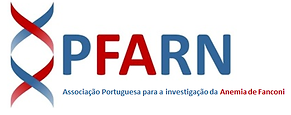
AF e instabilidade cromossómica
Na década de 80, demonstrou-se que, na origem da AF, está um defeito genético que envolve os mecanismos que procedem à reparação dos danos a que o DNA está sistematicamente sujeito. A doença passa, então, a ser classificada como síndrome de instabilidade cromossómica (IC) e é desenvolvido um exame laboratorial citogenético que, ao demonstrar a IC, se torna no teste mais importante para o diagnóstico da doença. O Laboratório de Citogenética do ICBAS, Universidade do Porto, além de ter implantado este teste de diagnóstico laboratorial, faz investigação sobre a importância da IC como fator determinante da falência medular e da suscetibilidade acrescida para o cancro, na perspetiva de estudar agentes profiláticos que limitem a progressão da doença.
Bolsas Internacionais
2024- International Fanconi Anemia Support Grant - " Connecting the FA community with doctors and researchers, to help FA families to face the challenges of the disease, to divulgate the continuous advances in FA research and to promote good clinical practices for the general Portuguese FA population."
2022- International Fanconi Anemia Support Grant - " Support the organization of the first FA meeting directed both for FA professional and FA families and tosupport the promotion of guidelines for the transition from pediatric to adult care"
Projetos de investigação realizados no ICBAS/CHP
2017- Innovative combined cytogenetic and immunophenotypic follow-up studies for patients with Fanconi anemia and other bone marrow failure disorders: for an early detection of myelodysplasia previous to a malignant transformation. Projeto do CHP nº 176/17 (151-DEFI/ 143-CES)
2017- Anemia de Fanconi: importância clínica do diagnóstico citogenético e da determinação do grupo de complementação. Projeto nº 174/2016, aprovado pela CETI, ICBAS,UP.
2016 - Increased red cell distribution width in Fanconi anemia: a predictive marker of stress erythropoiesis and advance outcomes. Projeto nº144/2016 , aprovado pela CETI, ICBAS,UP.
2012 a 2013 – Hematopoietic failure and prooxidant state in Fanconi Anemia: searching for causes and prevention against progression of the disease. Projeto do CHP nº 112/12 (086-DEFI/076-CES).
Artigos científicos publicados por sócios da PFARN
R Sousa, et al. Increased red cell distribution width in Fanconi anemia: a novel marker of stress erythropoiesis. Orphanet Journal Rare Disease (2016)
H Belo, et al. Epigenetic Alterations in Fanconi Anaemia: Role in Pathophysiology and Therapeutic Potential. PLoS One (2015)
B Porto, et al. Chromosome Instability in Fanconi Anemia. Can it be mitigated by antioxidant small molecules? Nova Publisher (2015)
G Pagano, et al. Bone Marrow Cell Transcripts from Fanconi Anaemia Patients Reveal in Vivo Alterations in Mitochondrial, Redox and DNA Repair Pathways. European Journal of Haematology (2013)
R Sousa, et al. Fosfomycin increases chromosome instability in lymphocytes from Fanconi Anemia patients. Mutation Research (2013)
G Pagano, et al. From clinical description, to in vitro and animal studies, and backward to patients: oxidative stress and mitochondrial dysfunction in Fanconi anemia. Free Radical Biology & Medicine (2013)
F Ponte, et al. Improvement of genetic stability in lymphocytes from Fanconi anemia patients through the combined effect of a-lipoic acid and N-acetylcysteine. Orphanet Journal Rare Disease (2012)
F Ponte, et al. Protective effect of acetyl-l-carnitine and a-lipoic acid against the acute toxicity of diepoxybutane to human lymphocytes. Toxicology (2011)
M Castella, et al. Origin, functional role and clinical impact of Fanconi anemia FANCA mutations. Blood (2011)
B Porto, et al. Fanconi anemia: cytogenetic diagnosis of 40 cases. Acta Médica Portuguesa (2011)
B Porto, et al. Normal red blood cells partially decrease diepoxibutane-induced chromosome breakage in cultured lymphocytes from Fanconi Anemia patients. Cell Proliferation (2010)
MJ Vale, et al. Audiologic abnormalities of Fanconi anemia. Acta Oto-Laryngologica (2008)
M Guerra, et al. Anemia de Fanconi – variabilidade fenotípica da doença em duas irmãs. Acta Pediátrica Portuguesa (2000)